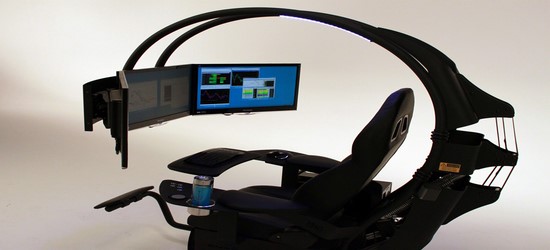The term heat sink isn’t one most people think of when they hear the word computer. But it is one of the most important devices without which modern computers couldn’t perform efficiently.
In the absence of a quality heat sink, the microprocessor, GPU, and other high-power semiconducting devices are at risk of overheating, which could ultimately damage the whole system, costing you a significant amount of money.
In this overview article, we have explained what heat sinks are made of, how do they work, and how many types of heat sinks are there. Let’s starts with the basics.
Table of Contents
What Is A Heat Sink?
Definition: A heat sink is a device that transfers the heat produced by a mechanical or electrical component to the surrounding medium, such as air or a liquid coolant. In other words, it keeps the component from overheating by absorbing its heat and dissipating it into the air.
It accomplishes this task by maximizing the surface area in contact with the cooling medium surrounding it. This medium is often air, but it can also be a refrigerant, water, or oil.
In order for a heat sink to work properly, the surrounding medium must have a lower temperature than the heat-generating component. The other factors that affect the performance of a heat sink include surface treatment, protrusion design, air velocity, and choice of material.
How Does It Work?
Heat sinks do not have magical powers to absorb heat like a sponge and send it off to a parallel universe. Their working principle depends on Fourier’s law of heat conduction.
As per this law, if there is a temperature gradient in material, heat will travel from the hot region to the cold region of the body. The rate of heat transfer (via conduction) is proportional to the cross-sectional area of the heat sink and the product of the temperature gradient.
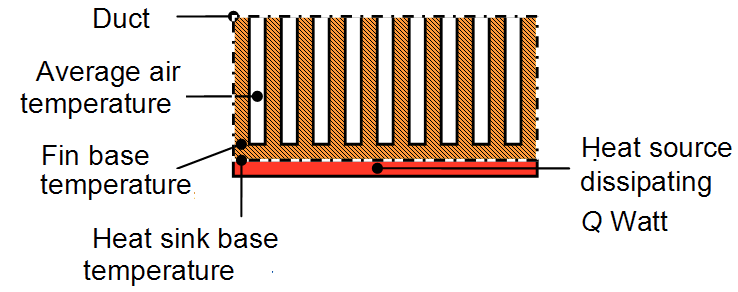
The thermal energy cannot be transferred if there is no free airflow over the heat sink. And the performance of the heat sink will not be up to the mark if fins aren’t vertically aligned or if they are tightly packed to allow enough flow of air between them.
Material
An ideal heat sink material has four key characteristics
- High thermal conductivity
- Low coefficient of thermal expansion
- Low density
- Low cost
Aluminum alloys are widely used for building microprocessor heat sinks. The 1050 aluminum alloy, for example, has much higher thermal conductivity (but lower mechanical strength) compared to other alloys. It exhibits a thermal conductivity of 229 watts per meter-kelvin (W/m•K).
Aluminum alloys 6063 and 6061 are also commonly used to manufacture one-piece material heat sinks. They have thermal conductivity values of 201 and 166 W/m•K, respectively.
Copper has nearly twice the thermal conductivity (401 W/m•K) of aluminum and exhibits superior properties in terms of antimicrobial resistance, corrosion resistance, and biofouling resistance. However, it is less ductile, more expensive, and three times denser than aluminum.
Copper heat sinks are made by milling or skiving. Many manufacturers solder sheet-metal fins onto a rectangular copper body. Some heat sinks are made by affixing multiple aluminum fins to a copper base. Such designs combine the benefits of both materials.
Another suitable material for creating heat sinks is diamond. Its thermal conductivity (2200 W/m•K) exceeds copper 5-fold. But due to its high costs, the use of diamond heat sinks is limited to specialized, high-power integrated circuits and laser diodes.
A few composite materials, such as copper-tungsten pseudo alloy, Dymalloy (diamond in copper-silver alloy matrix), and AlSiC (silicon carbide in aluminum matrix), provide the perfect balance of cost, availability, and heatsink performance.
Types
Heat sinks can be categorized based on three parameters: convection, fin arrangement, and the manufacturing process.
Based on Convection
Passive heat sinks dissipate thermal energy through the natural convection process. This means buoyance of hot air alone causes the airflow produced across the heat sink system. The heat is spread over a large area and then radiated away from thin strands called fins. These heat sinks do not require any control module or secondary power to remove heat from the system.
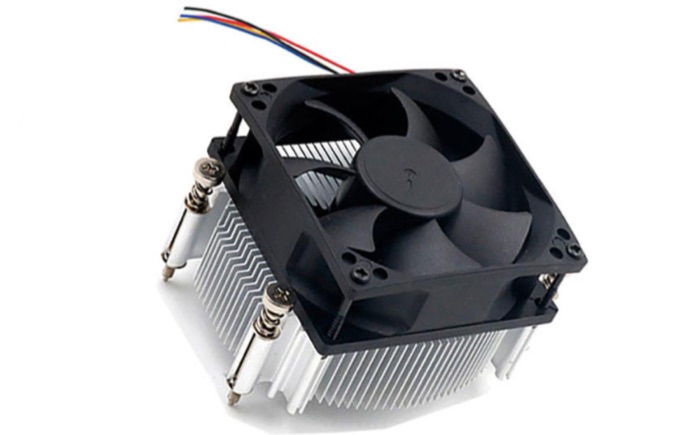 An active heat sink with an electric fan
An active heat sink with an electric fan
Active heat sinks utilize forced convection to increase the flow of the fluid across the hot region. This forced convection is usually provided by a blower or a fan, which circulates the air, diverting heat away from components. Since they are more effective at transferring heat from a system than passive heat sinks, almost all high-end desktops use active cooling.
Based on Fin Arrangement
 Straight, pin, and flared fins (from left to right) | Wikimedia
Straight, pin, and flared fins (from left to right) | Wikimedia
Straight fins run the complete length of a heat sink. They are attached to the base at even intervals. All fins are mounted at a 90-degree angle (parallel to each other) to allow maximum area for fluid flow.
Pin fins extend from the base and cover a large portion of surface area on the heat sink. The pins can be square, elliptical, or cylindrical, and they work well in all orientations. These types of heat sinks perform substantially better than straight fins in certain applications where fluid flow trajectories are axial (instead of tangential) along the pins.
Flared fins are similar to straight pins, except they are not parallel to each other. These heat sinks contain long fins that are tilted to an angle. The design reduces the flow resistance and allows more air to pass through the fin channel, providing better thermal performance than straight fin heat sinks.
Based on Manufacturing Process
Extruded heat sinks are made using the extrusion manufacturing process, in which a material (mostly aluminum) is pushed through a die of the desired cross-section. Although dimensions of final products are limited by the maximum width of the extrusion, it is easy to manufacture custom specifications at low costs.
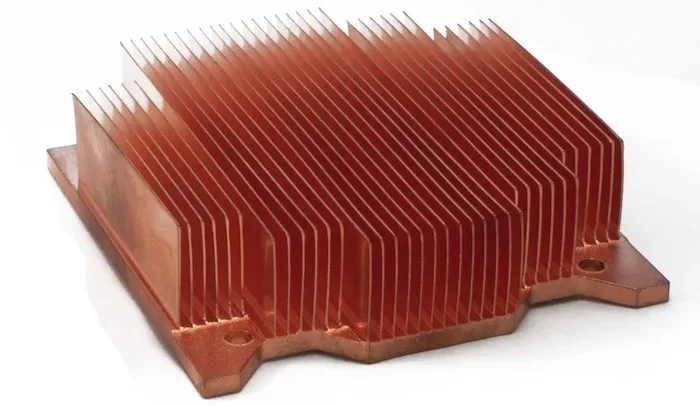 A skived heat sink made of copper
A skived heat sink made of copper
Skived heat sinks are created by a process called skiving or scarfing, in which a material is cut off in thin slices. A single block of material, such as copper or aluminum, is used. These heat sinks offer superior thermal properties because they contain a dense population of evenly shaped and distributed fins,
Forged heat sinks are made by shaping the material with localized compressive forces. The manufacturing process takes place in a low temperature and high-pressure environment so that no impurities or air bubbles are trapped in the metal. The main benefit of this process is heat sinks of the same design can be created with different heights using only a single set of forging die.
 A bonded heat sink
A bonded heat sink
Bonded heat sinks contain a grooved base with individual fins bonded into the grooves. Grooved bases can be machined, extruded, or die-cast. Fins are soldered, brazed, or thermal epoxy-bonded, depending on heat resistance requirements. They can be made of a combination of materials such as copper, aluminum, and stainless steel. This type of design provides decent thermal performance without adding much weight.
Stamped heat sinks are made by stamping metal fins and then soldering them onto the base. They are lightweight and inexpensive to manufacture. However, they may have sheared edges, die marks, or rough surfaces, and aren’t suitable for high-end applications.
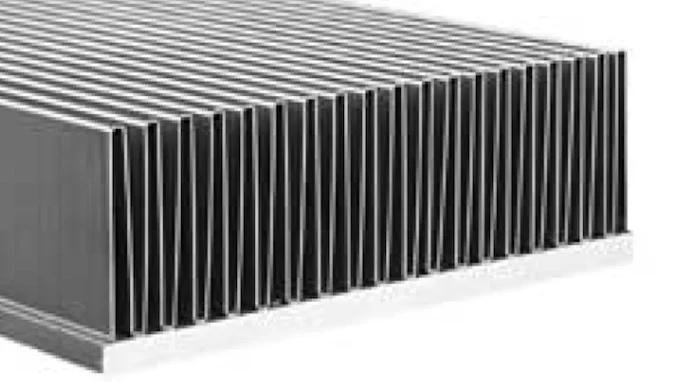 A folded heat sink
A folded heat sink
Folded heat sinks are created by folding sheet metal into a serpentine fin array. The sheets are attached to the base by brazing or soldering. And since the folded fins are flattened in the manufacturing process, it increases the contact surface area, which results in an additional thermal resistance.
CNC machined heat sinks are manufactured by using a gang saw machine, which contains multiple saw cutters on an arbor. The computer numerical control (CNC) system operates the machine to create precise inter-fin spaces. The process is fast, but it consumes a lot of material in an unproductive manner. In most cases, fins are distorted or damaged and require secondary operations.
How Is Heat Sink Performance Calculated?
The performance of a heat sink usually depends on airflow rate, heat transfer coefficient, fin-type, material thermal conductivity, and duct size. The thermal performance can be determined via three methods:
- By measuring the performance experimentally,
- By creating a theoretical model, and
- By using numerical analysis and data structure technique called computational fluid dynamics (CFD).
While theoretical models are used as a first-order estimate and experimental tests are quite costly and time-consuming, most manufacturers prefer CFD to estimate heat sink temperatures in the system before constructing a physical model.
CFD provides both quantitative and qualitative estimation of fluid flows. It gives detailed insights into flow patterns that are costly and difficult to analyze using experimental techniques.
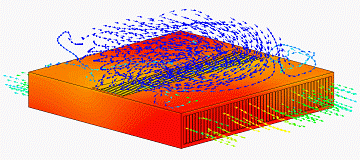 A CFD animation of a 6*6*1 cm straight finned heat sink, showing thermal profile and convection flow trajectory from a tube-axial fan | Wikimedia
A CFD animation of a 6*6*1 cm straight finned heat sink, showing thermal profile and convection flow trajectory from a tube-axial fan | Wikimedia
The preciseness of the post-processed animations and simulations relies on the accuracy of the appropriate parameters entered into the CFD tool.
Read: 12 Examples Of Thermal Energy In Everyday Life
Applications
Heat sinks can be used with any component that requires heat dissipation to operate correctly. This includes electrical, mechanical, chemical, and nuclear sources. The three most common devices that utilize heat sinks are:
CPU/GPU: In desktops, heat sinks are used to cool microprocessors, graphical processing units, RAM modules, and some chipsets.
For example, NVIDIA Jetson Nano contains a large heat sink to maintain the temperature of the onboard AMD processor and Maxwell GPU, both of which produce significant amounts of heat and require extraordinary cooling to avoid thermal throttling.
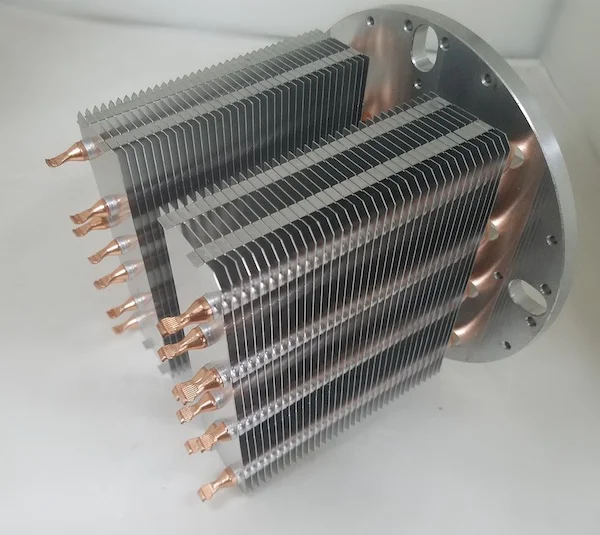 200W LED heatsink with Heatpipe
200W LED heatsink with Heatpipe
LED: Although light-emitting diodes are cool to touch, they store plenty of unwanted heat within the device. This heat comes from semiconductors that convert 10-40 percent of the input power into light. The rest of the energy is lost as heat.
A heat sink is used to dissipate that extra heat via conduction and convection. It allows the LED to operate at ambient temperatures, which in turn increases the lifespan of the device.
Read: NEMS – NanoElectroMechanical Systems | A Simple Overview
Solder: Some electrical components, such as magnetic reed switches, can be damaged by heat when soldering. Therefore, electricians often use a heat sink clipped to the lead between the joint and component body. The heat sink takes a portion of heat being supplied by the soldering machine, preventing damage of nearby sensitive components.

